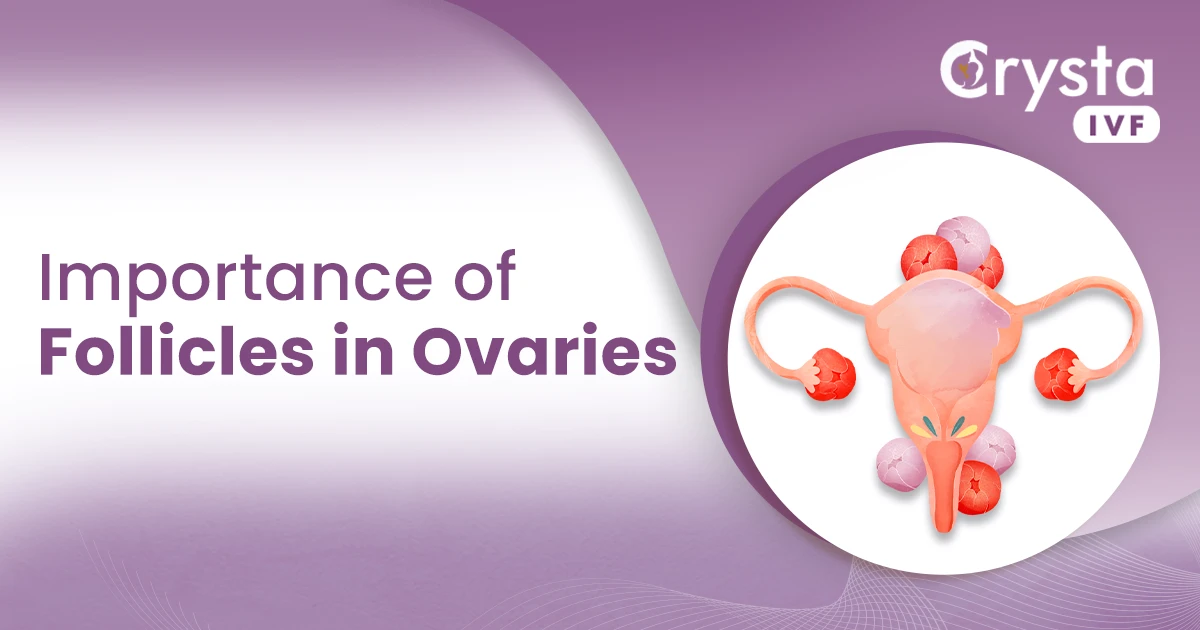An essential part of the female reproductive system, the ovarian follicle, is critical to human reproduction. Developing eggs, or ova, are housed and nurtured in these tiny structures inside a woman’s ovaries as they get ready for possible fertilization.
Follicles in ovaries support the development and maturation of a single egg by acting as a protective capsule. The ovarian follicle undergoes a series of well-coordinated phases, progressing from primordial to mature, as a result of hormonal regulation involving multiple hormones, with follicle-stimulating hormone (FSH) and luteinizing hormone (LH) playing prominent roles.
Comprehending the ovarian follicle’s intricate workings is essential to understanding menstrual cycles, Fertility, and reproductive health. This article explores the physiology, anatomy, and importance of ovarian follicles, providing insight into their function in the amazing process of human reproduction.
Also Read: Understanding Your Reproductive System
Definition of ovarian follicles
Let’s understand ovarian follicles in detail. The ovaries are part of the female reproductive system on both sides of the uterus. They have two functions –
- Release an egg during ovulation
- Responsible for releasing estrogen and progesterone, sex hormones that support implantation and other functions.
Ovarian follicles are like little sacs filled with liquid in a woman’s ovary. They have the important job of letting out one egg each month for fertilization. But the egg isn’t fully grown yet when it’s still inside the follicle. As the menstrual cycle continues, the egg grows, and the follicle lets it go, preparing it to be fertilized. It’s a natural process that happens in women’s bodies, helping them have the possibility of getting pregnant.
Also Read: What are the Phases of the Menstrual Cycle?
But if the follicles do not release the egg, they may swell and become cysts. An ultrasound in a woman’s pelvic region can help doctors evaluate ovarian follicles. Doctors also perform an antral follicle test to count the number of follicles in the ovaries and know their size. A healthy number of follicles helps determine the likelihood of pregnancy.
Size of normal ovarian follicle
Other than the number of follicles in the ovary, the size also matters. A healthy follicle size ranges between 18 and 22 millimeters in diameter. Once the follicles are the right size, it means estrogen levels are rising, and the uterine lining has thickened, implying that the egg is ready to be released for fertilization.
Stages of development of the Ovarian Follicles
The stages of follicles in ovaries mean how much the follicles have developed. The follicle development has been divided into six stages:
- Primordial Follicle: All follicles start as primordial follicles. At birth, about 1-2 million of them are in the ovaries. It takes almost a year for them to grow into the ovulatory stage. These follicles are surrounded by cells called granulosa cells, which make estrogen.
- Primary Follicle: Some primordial follicles become primary ones every day, from puberty until menopause.
- Secondary Follicle: Granulosa cells increase estrogen production, and the follicle develops pockets of nutrient-rich fluid. This later becomes the antrum, a fluid-filled space.
- Tertiary Follicle (Antral Follicle): Developed from secondary follicles, these are visible on ultrasound scans.
- Graafian Follicle: This mature follicle is ready for ovulation.
- Corpus Luteum: After ovulation, the empty follicle transforms into the corpus luteum, producing progesterone during early pregnancy.
The Corpus Luteum is a temporary structure made from a group of cells that takes the place of the egg after it is released. This group produces progesterone. In the event of a pregnancy, progesterone supports the initial phases. The Corpus Luteum degrades, and the cycle restarts without pregnancy. Consider it a team that assists in preparing everything if a baby is expected
Also Read: Luteal Phase Defect: Symptoms, Causes, And Treatment
Relation between Follicles and Fertility
There are approx 2,000,000 eggs in a woman’s ovaries when they are born. The numbers reduce to 400,000 when they hit puberty. It decreases further during menopause when the number of eggs dwindles to 1000.
Each follicle has only one egg, and these follicles make a woman’s ovarian reserve. However, as per a study in 2018, it was found that not all follicles reach maturity to release an egg.
As the number of follicles decreases, the ovarian reserve in women also decreases, implying that women with low reserve have less chance of conceiving.
Ovarian Follicles and Menopause
Menopause is a phase in women where they no longer have periods and can no longer become pregnant naturally. Women who are at menopause can encounter vaginal dryness and also suffer from hormonal imbalances, causing the body to produce less estrogen and progesterone. The ovarian follicles reduce in numbers as women enter menopause.
Conditions that affect Follicles:
- Polycystic Ovarian Syndrome (PCOS): Women with PCOS release high levels of androgens, which are male sex hormones that are released in very low quantities in women. It can cause women acne and excessive body hair. Women with this condition have an excess of immature ovarian follicles, affecting their chances of conceiving as it does not allow the follicles to release egg cells.
- Cysts: This condition can cause follicles not to release the eggs. Although they are not cancerous, they can affect a woman’s Fertility. Conditions like PCOS and endometriosis can cause cysts to form.
- Primary ovarian insufficiency: When the ovaries stop functioning before age 40, it is known as primary ovarian insufficiency or premature ovarian failure. Reduced fertility and irregular periods are the results of this condition. Individuals with low follicle counts or genetic disorders may experience premature ovarian failure.
- Ruptured ovarian cysts: Ovarian cysts are common in women who are menstruating. If the cysts burst, women can experience:
- Vaginal Spotting
- Bloating in the abdomen
- Back pain
Once cysts have ruptured, surgery is necessary to treat further complications.
Ovarian Follicles Diagnosis
Diagnosing ovarian follicles involves these procedures:
- Pelvic Ultrasound: This helps doctors diagnose the size of the ovaries and the number of follicles present in a woman.
- Blood Tests: Measures hormone levels and check if the woman has diabetes or high cholesterol. They also impact the number of follicles present in the ovaries.
- Laparoscopy: it’s a surgical procedure done on a woman where a special instrument is inserted into the abdomen to examine the cysts and ovaries.
Treatment for Conditions that Affect Ovarian Follicles:
Doctors have multiple treatment options for conditions affecting ovarian follicles, such as:
- Supplements containing calcium and vitamin D are crucial for primary ovarian follicle insufficiency. It lessens the chance of developing osteoporosis.
- Birth control pills reduce the risk of ovarian cancer, treat PCOS, and help regulate menstrual cycles.
- PCOS can be treated by changes in lifestyle, like regular exercise and a healthy diet.
Conclusion:
In summary, ovarian follicles are essential for reproductive health and Fertility. Frequent examinations, such as blood tests and pelvic ultrasonography, aid in diagnosing diseases affecting these follicles.
Understanding ovarian follicles can help manage diseases like cysts and PCOS, which can affect fertility. It becomes imperative to see a doctor if you are having symptoms or are looking for information on fertility.
People aware of ovarian follicles are better equipped to make decisions regarding their reproductive health and, when necessary, seek the advice of qualified medical professionals.
Read more blogs:
- Low Testosterone in Females: Causes, Symptoms and Treatment
- How to Increase AMH Levels Naturally?
- What is PCOS? How to cure PCOS permanently?
- How To Get Pregnant With PCOS?
 Verified by Crysta IVF Fertility Experts
Verified by Crysta IVF Fertility Experts
FAQs
Q. What does it mean to have ovarian follicles?
Ans: Normal Follicles in ovaries mean that women can release an egg during ovulation for conceiving. It also releases estrogen and progesterone, sex hormones that support implantation and other functions.
Q. Why are ovarian follicles important for Fertility?
Ans. Ovarian follicles hold immature eggs, and releasing a mature egg (ovulation) is key for pregnancy. They also create hormones affecting your menstrual cycle, preparing your body for a potential fertilized egg.
Q. Which size of follicle is good for conception?
Ans. Your follicles are considered ready for egg collection when they are between 18 and 20 mm long.




